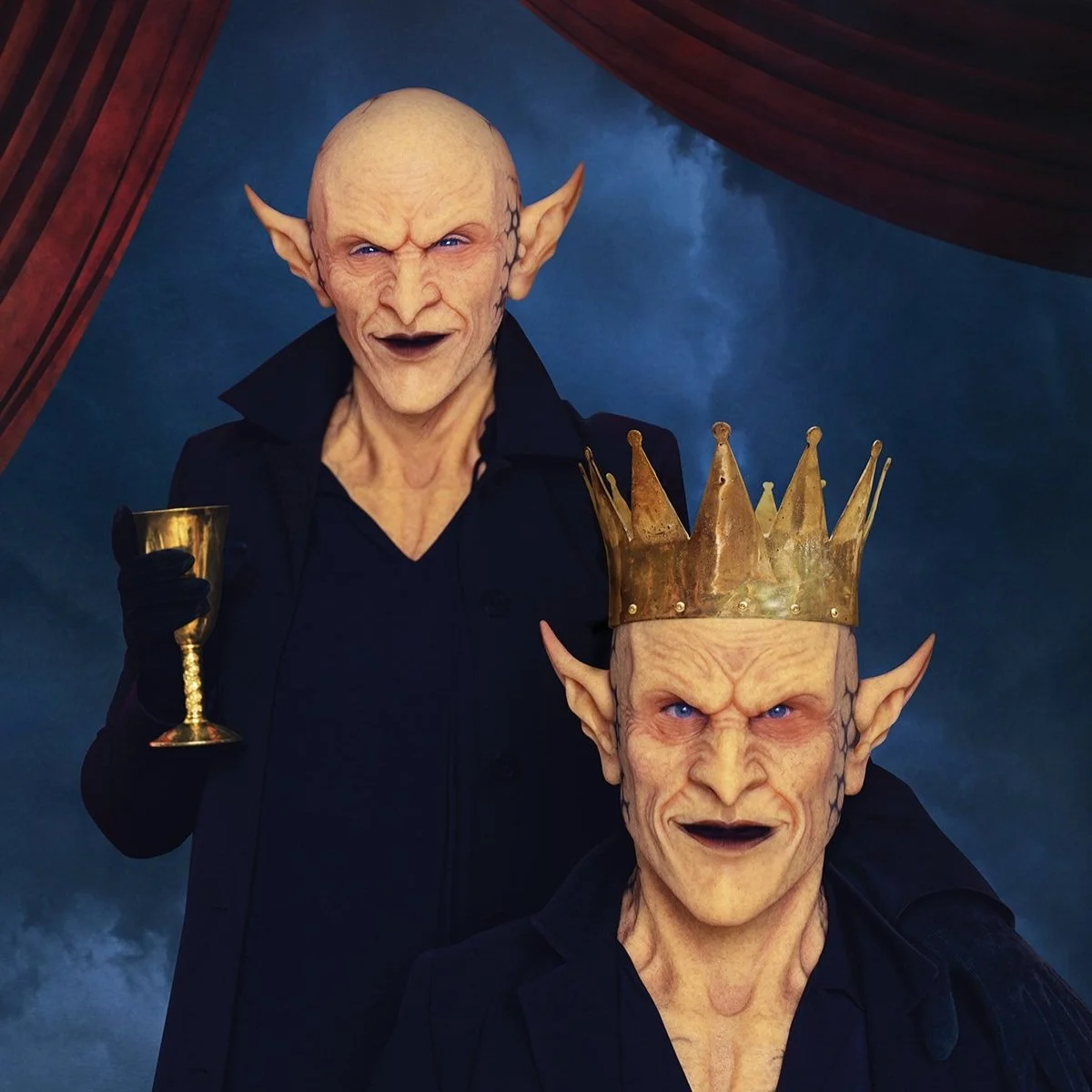Goblin:Macbeth strikes a hit combo of eerie masks, improv comedy, and Shakespearean finesse
Rebecca Northan, the talent behind Blind Date, has learned to follow her “weird ideas”, all the way to Bard on the Beach and Stratford Festival
Actors play multiple roles in special-effects masks in Goblin:Macbeth.
Bard on the Beach presents Goblin:Macbeth at the Howard Family Studio Stage from August 19 to September 17
CANADIAN THEATRE INNOVATOR Rebecca Northan calls it an artistic breadcrumb trail: all the random influences that came together to lead to the utterly unique creation of her and Bruce Horak’s Goblin:Macbeth. Those crumbs included the mask work and improv the pair had done at Loose Moose Theatre and the extensive Shakespeare performances and workshops she and her creative partner had done in parks and in schools.
But there was perhaps no bigger inspiration than the pointy-eared, squinty-eyed masks themselves. Several years ago, a friend drew Northan’s attention to the wild latex and silicone creations by a U.S. company called Composite Effects—ones whose mouths and cheeks move with every word and expression of the wearer.
“The moment I saw them, I was like, ‘I have to do a show with these someday,’” says the actor-playwright, speaking from Niagara-on-the-Lake, where she’s performing in the Shaw Festival all summer. “But they're so expensive. They're soooo expensive. I was like, ‘Um, this is gonna take me some time.’ Just to save up money.”
Northan and Horak finally got that chance to use them in Calgary in 2021, when The Shakespeare Company suddenly needed a replacement for a Macbeth production that was downed by COVID. The result? An instant hit—with Calgary theatre fans loving the three eerily lifelike, sickly-greenish goblin masks worn by Northan, Horak, and multi-instrumentalist Ellis Lalonde. (Bard on the Beach favourite Colleen Wheeler takes Northan’s role here.) In the play-within-a-play, the ghoulish creatures discover The Complete Works of Shakespeare and decide to perform Macbeth, playing multiple roles each.
Wearing the masks, it turns out, is not as spectacular as watching someone wear them.
“On the very practical level, one of the things about these masks is that it is like running a marathon with a latex bag on your head,” says Northan. “Like, it is a feat of athleticism done under extreme conditions. I've never sweat so much in my life. So there's that, but the other thing about these masks is they are wearable works of art. I had a friend come up after the show and say, ‘I can't talk to you while you're wearing it; it’s too freaky,’ because what happens is the persona of the person disappears—like, in the best, juiciest, most theatrical way, you really feel like you're in the room with another presence.”
To really understand how Northan and her creative team were able to pull off this offbeat take on Macbeth—one that veers fluidly between lunatic goblin antics, masterful moments of Shakespeare, and seat-of-the-pants improvised audience participation (more on that later)—it’s important to back up a bit.
Northan‚ as well as Horak, Lalonde, and even Wheeler, cut their teeth on improvised comedy at Loose Moose. Northan has honed and elaborated on that form much more over her long career—most notably in Dora-award-winning Blind Date. In the show, which has played to sold-out crowds over the years in Vancouver, the red-clown-nose-wearing Northan gamely invites a member of the audience each night to join her onstage for a “date”.
She draws on improv in almost all her work—and loves the idea of “real creativity in real time”.
“Improvisation means that we're being responsive to who is in the audience on that night,” she explains. “It means that every performance is slightly different. So then we're able to go ‘Yeah, tonight was special because of who was here.’ And I think an audience can feel that. The thing that the clown nose and the mask and the improvisation can offer to a ticket buyer is ‘I see you. I see you. I see that you put on hard pants and you've left your house, and now we're in the space together. And because I see you and you feel seen, we're in an exchange that just cannot happen through a screen.’ And I think that we are hungry for that real human connection. You know, and that's a different AI. Like there's ‘artificial intelligence’ but this is ‘authentic intelligence’: that’s ‘I see you you see me now now we're in a relationship and something's gonna happen.’”
Northan stresses the audience interaction in Goblin:Macbeth is “participation light”; the viewers might wave branches or make trumpet sounds together.
“We don't single anybody out,” Northan explains. “We don't bring anyone up on stage. It’s like, well, there's safety in numbers, and it's actually easier to play along with us and to offer participation—or not!— from the safety of your seat. It’s the notion that instead of us standing on stage and delivering something to you, who sit in the dark and digest it, what we do is we kind of envelop you in the production with us.”
From the outside, switching between the often uproarious interactive antics of the show back into articulate performances of the script would seem beyond challenging; think the floating-dagger speech, or the “Tomorrow” sequence. Northan, who has a deep love of words and language, shrugs it off; back at Quest Theatre, when she and Horak did those weeklong workshops at elementary schools, they did Macbeth so many times, they know it inside-out.
Still, she adds: “One of the things that was really important to Bruce and me when we were creating the show was if you're going to—excuse my swearing—fuck around with Shakespeare, you better be really, really good at it. You earn the right. This is what we wanted for ourselves. We want to earn the right to be able to misbehave and poke sticks at the text.”
As for the goblins, they allow audiences to understand the cursed Scottish play in a new way—to see it not just as macabre, but to discover the humour Shakespeare embedded in the text, making the tragedy more bearable. And the monstrous creatures invite viewers to experience theatre in a new way, through new eyes—and pointy ears.
“In our world that we've created, the goblins aren't too sure about theatre in general,” Northan says. “They're very skeptical, but they're curious because they have found the complete works of William Shakespeare. And they've gone, ‘This guy writes a lot about fairies and witches and goblins—maybe we should give him some credit and explore it. We're not convinced of theatre as a practice. But let's try it.’ And then they discover the language is beautiful.”
From that celebration of language to the masks that look straight out of J.R.R. Tolkien, the farflung “breadcrumbs” that have coalesced for Goblin:Macbeth are hitting a sweet spot with audiences. She is already set to develop a Goblin:Oedipus for Alberta’s One Yellow Rabbit. Here at Bard on the Beach, the show is already 95 percent sold out and it hasn’t even opened yet.
“I’ve never seen anything sell out before its run—like, I've never been involved in anything that had less than 100 tickets left two days before opening. I don't even know what to do with that. I just go ‘Oh, I guess we accidentally created something people are interested in.’ To me, it’s a great lesson. I teach a lot—I'm a guest instructor at the National Theatre School—and I say to young students all the time: ‘It’s actually really important that you hold on to what tickles your fancy. And it's okay to be slightly, you know, left of center or to go have a weird idea. Yes, you must follow your weird idea. Because you don't know where it'll lead you.’”














